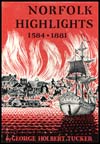Chapter 43
Norfolk and the Navy
Norfolk has always been a Navy town, a tradition it is likely to maintain as long as men go down to the sea in ships.
From the time of the founding of the town in the late Seventeenth Century, an ever-increasing commerce necessitated the establishing and maintaining of taverns and boarding houses along the waterfront to accommodate the captains and crews of vessels between voyages. And the nearness of Norfolk to the sea soon made its harbor a favorite rendezvous for foreign men-of-war.
This is evident from the recollections of Mrs. Helen Calvert Maxwell Read, whose father, Maximilian Calvert, was mayor of Norfolk in 1765 and 1769.
In her old age, Mrs. Read liked to recall how the visit of thirty-two midshipmen from a fifty-gun British ship, "mostly boys and lads of good families, and several of them sprigs of nobility," set the hearts of Norfolk damsels aflutter.
But the picture also had its darker side; and throughout most of its history, Norfolk has also been troubled occasionally by serious riots caused by sailormen.
In the main, however, Norfolk's nautical history has been glamorous.
Two famous Nineteenth Century expeditions set out from Norfolk-area waters to make world history. In August of 1838, the first national exploratory expedition authorized under a special act of Congress, known as the Wilkes Expedition, left Norfolk for a four-year cruise to survey and chart areas in the Pacific Ocean and the South Seas, particularly those parts most frequently used by American whaling vessels. On November 24, 1852, Commodore Matthew Calbraith Perry left Norfolk on the paddle frigate Mississippi, the nucleus of the "Japan Squadron" that resulted in the opening of the ports of Japan to the United States two years later.
Over the years Norfolk has been the scene of thousands of marriages between seagoging men and Norfolk girls, giving the city, among others, the nickname "The Mother-in-Law of the Navy." Notable among these was the marriage of Commodore Stephen Decatur and Miss Susan Wheeler, which took place on March 8, 1806, and the two marriages of Admiral David Glasgow Farragut.
Farragut's first marriage, to Miss Susan Caroline Marchant of Norfolk, took place on September 1, 1824. After her death he married another Norfolk girl, Miss Virginia D. Loyall, on December 26, 1843.
But Farragut had other Norfolk connections.
Early in 1811, the ten-year-old lad, who was already a midshipman, had a memorable encounter on the Norfolk waterfront that has become a part of naval history.
When the gig of the man-of-war Essex, commanded by Captain David Porter, was standing by at a Norfolk wharf awaiting the return of Porter from some business ashore, a crowd of dock loafers began making fun of the bantam midshipman. Young Farragut faced his tormentors in silence until one of them began sprinkling him with a water pot "to make him grow."
Quick as a flash, Farragut snagged the fellow with his boat hook and yanked him down into the gig. The sailors, idling at their oars, were spoiling for a fight, and this was their signal.
Led by Farragut, who brandished a dirk, they leaped from the boat and drove the hecklers up what was then known as Market Square, later as Commercial Place. Minutes later, the law took over, and Farragut, his companions, and his tormentors were taken before a justice, who bound them over to keep the public peace.
When Captain Porter heard of the affair, however, he was delighted at his protege's prowess and praised him for being "three pounds of uniform and seventy pounds of fight."
Chapter
44
Norfolk's Civil War Phase
Norfolk Highlights 1584 - 1881

See the "Table of Contents" for links to every chapter in Norfolk Highlights 1584 - 1881 by George Holbert Tucker.
